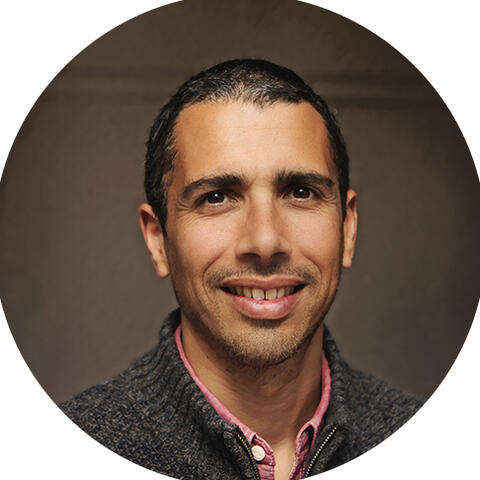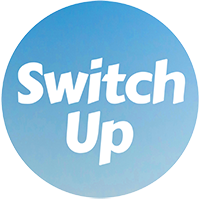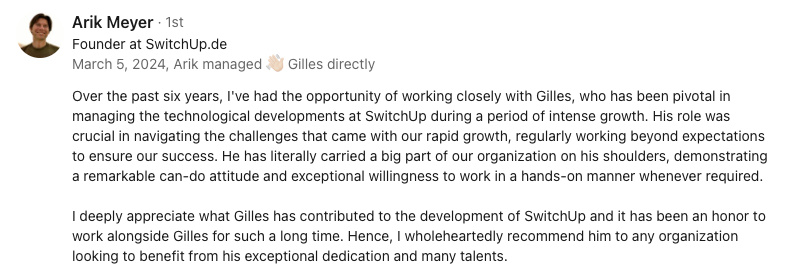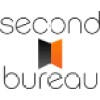Abstract:
The article emphasizes that professional profiles are most effective when they showcase a single, standout "trust signal"—such as a key project, strong testimonial, or major achievement—rather than an overwhelming list of credentials and endorsements. Drawing on psychological principles like the Von Restorff effect and frameworks from branding, it explains that focusing on one clear proof point makes a reputation memorable, credible, and easy for others to recommend. The piece offers practical strategies for identifying and presenting this signature trust signal, including self-assessment tools, real-world examples of tech professionals known for one major accomplishment, and guidance on adapting your trust anchor when your career shifts. Unique elements include checklists for self-auditing, advice on visually aligning your trust signal across platforms, and a personal anecdote: the author describes their own minimalist approach to personal branding while moving from science entrepreneurship in Paris to tech leadership in Berlin and Lisbon, each time updating their public proof point to reflect their new focus. Ultimately, the article argues that minimalist branding—centering your story around one clear, verifiable trust signal—cuts through noise, builds trust, and adapts to growth, proving that doing less can make you stand out more.
Every professional profile comes with its own mix of skills, endorsements, and badges. But does having more always mean better? Many people find that piling on credentials can actually work against them, creating confusion instead of clarity. For independent tech professionals, this confusion can mean missed opportunities and added anxiety about standing out in a crowded field. I know that feeling well—when I first started working on my own, I worried that not listing every achievement would make me invisible. But over time, I learned that focusing on a single, standout trust signal often gets you further than listing everything.
You'll find simple frameworks from psychology and branding that show how one clear proof point—like a key project or a strong testimonial—can make your reputation memorable. I’ll share what makes trust signals really work, how I found my own, and why less is usually more. Real-world examples and straightforward checklists help keep the advice practical, while a friendly tone makes the topic feel light.
The benefit? You’ll see how a focused trust signal doesn’t just simplify your story, but also attracts the right kind of attention. Standing out might be a lot simpler and lighter than you expect.
Single trust signal impact
Why one trust signal works
A LinkedIn profile stuffed with certifications, endorsements, and project badges can be overwhelming. Psychology teaches us that when faced with lots of credentials, people remember fewer details. Our brains just can’t process so much information at once. When profiles list too many achievements, they create overload and actually hide what makes someone unique. A single, standout proof point, it sticks in people’s minds and looks more convincing than a busy list. I’ve seen this firsthand—when I first shifted from corporate roles to consulting, I noticed that clients remembered my work on a single project far more than my list of certifications.
The Von Restorff effect, or “isolation effect,” shows that something standing out alone is easier to remember than things in a crowd. Many in tech become known for one big contribution. For example, tech professionals with a single, well-known project receive more inbound offers than those with many minor achievements (INSIGHT). Their reputations are tied to that one achievement, making it easy to remember and talk about.
Frameworks about trust and credibility say that authority and social proof work best when focused. By showing fewer credentials, you can actually make your expertise feel stronger. But what makes a trust signal really stick?
Magnetic trust signal traits
A good trust signal is specific, relevant, and easy to check. It links directly to the results your audience cares about. The most effective trust signals for tech professionals usually share three things:
- They are concrete, like “creator of X project.”
- They are relevant to the people you want to reach.
- They can be verified quickly online.
You’ll often notice these in real tech careers—big achievements, strong testimonials, or clear public contributions. A key point is how easy these signals are to check. For example, someone known for leadership in a non-profit, or with public testimonials, quickly builds trust. In fact, public testimonials from recognized industry leaders increase profile engagement by 40% (FACT). These signals are direct and stick fast.
People who keep highlighting one strong proof point are remembered for that field. It’s simple—when your profile is built around a single signal, you stand out and invite the right offers. So, how can you find your own signature trust signal?
Finding your signature trust signal
Self-discovery frameworks
A smart way to start is to look at your public presence with a trust framework. Here’s how I approach it:
- Check your reputation: What do people say about you online or in person?
- Review your profiles: Are they consistent and focused?
- Gather positive feedback: What compliments or endorsements come up most?
- Note references from others: Who is vouching for you, and for what?
This helps spot which type of trust signal feels most true and strong for you. You might also check which principles of influence fit your path best:
- Authority: Strong credentials or skills.
- Social proof: Others vouching for you.
- Consistency: Regular positive results.
Thinking this way helps focus on the trust signals your audience will care about. You can use the Trust Equation too—does your story show more credibility, reliability, or a good personal touch?
Trust grows when credibility, reliability, and connection are strong, and self-focus is low. Figure out your best quality by looking at what others mention about you. Peers might bring up technical skills, or a client might talk about how dependable you are. Looking for these patterns, combined with your own view, points to your key trust anchor. Some questions make it easier:
- What do clients often mention in recommendations?
- Is there a project people connect with your name?
- What gets you the most questions or interest?
Patterns here usually guide you to your strongest proof point. Once spotted, it’s about picking the right way to present it.
Picking the right signal
Each trust signal type offers something unique:
- Testimonials: Good for trust with clients or partners.
- Artifacts: Good for technical jobs or showing skills.
- Project outcomes: Good for leadership or business impact.
For people working with clients, a strong testimonial or case study works well. In more technical roles, a well-known open-source contribution or public artifact stands out. Match your trust signal to your audience to make yourself easier to spot. Stories help too, especially when paired with hard proof.
Stories can build connection, but their power grows when you back them up—like a press mention or clear result. For example, telling the story behind a project hits harder if you can point to a public case study or award. Mixing story and evidence shows both trust and authenticity. Once you choose your signal, make sure it shows up everywhere.
Making your trust signal visible
Consistent, not copied
Consistency means your trust signal gets noticed across all platforms—LinkedIn, website, or even an email signature. Keep the main message the same, but adjust the details for each platform. For example, tell the full story on your website, but use a short tagline on LinkedIn. This makes your expertise easy to recall. Visuals matter here too—let's dig into that.
Visual alignment
When you use visuals, like badges or testimonial quotes, keep them looking the same everywhere. Use matching colors, fonts, and icons. For example, having a testimonial badge look different on your website and LinkedIn just confuses people; matching visuals boost recall. Still, adapt your signal to fit each place.
A long testimonial might fit your website, but only a short version belongs in a LinkedIn summary. Used well, your story is always clear but never feels forced. Less is more here.
Contextual, not repetitive
Keep your trust signal tailored for each platform, so it feels fresh and fits in, not copy-pasted everywhere. A developer might display a full project on GitHub, and just mention “creator of X” in a bio elsewhere. This keeps your story easy to remember, wherever people see you.
Minimalist branding, maximum clarity
Less clutter, more impact
Minimalism isn’t just about looking sharp—it’s practical. Having one main trust signal means you don’t stress about updating lists or trying to impress everyone. Think of it as keeping your desk tidy—less clutter, less headache. It helps others talk about you for the right reasons.
Easy to remember and recommend
A clear trust signal lets clients or partners know what you’re all about right away. They can then recommend you, or connect with you, without guessing. Piling on too much muddies the message. Simpler is better—you get remembered for what counts.
When too many trust signals backfire
Too many signals, less impact
It might sound like more achievements help, but studies show that if you mix a big achievement with lots of smaller ones, people tend to average the value instead of adding it up. Showcasing one major award alongside extra certificates can actually lower the impact. This is called the Presenter’s Paradox. Instead of looking impressive, you risk blending in and losing your advantage.
It’s easy to feel anxious about being overlooked when you see peers stacking credentials, but I’ve found that clarity, not quantity, wins trust. Too many signals might even make people doubt you. When someone displays endless badges, testimonials, and projects, it can make audiences question how genuine you are. This overjustification effect leads people to wonder what really matters. Keeping it simple avoids this, making your message believable.
A focused trust signal keeps your profile sharp and easy to trust. Research shows again and again that one strong proof point is better than a messy mix of claims. Lots of well-known tech profiles prove this point.
Profiles that stand out
Many respected tech leaders are known for one key achievement. For example, someone might be remembered as creator of a famous product, or known for their work at a major company. Their trust signals open doors without needing a long list of credentials. On the other hand, profiles crowded with random badges and long lists leave people unsure about what that person actually does. If people can’t connect your name to a specific result, it’s hard for them to recommend you or reach out with the right chance. One memorable trust signal makes you noticeable and easy to remember.
A single anchor point means your profile is easy to scan, like a clear sign on a busy street. But your trust signal should change with your growth—pointing to your latest strengths.
Evolving your trust signal
Swapping signals during a pivot
Changing careers often means your old trust signal doesn’t fit anymore. For example, moving from engineering to product management, or going from a company job to consulting, means you need a fresh anchor. The minimalist approach is to swap, not stack—replace the old proof point with the new. If your headline used to be "Backend Developer, Open Source Contributor,” but now you’re in product, update it for your new impact. Before: lots of technical badges. After: leadership results and relevant testimonials. This keeps your brand clear as you move.
Making these changes felt risky at first, but focusing on my most recent strengths helped me attract the right kind of work, even outside the safety net of big companies. To avoid confusion, look through your bios and profiles and make sure everything matches your new specialty. Outdated trust signals can mix up your message. Try this checklist:
- Review all your professional bios.
- Update your LinkedIn headline and main sections.
- Refresh your website and remove old examples.
- Update email signatures and other details.
Ask for endorsements that relate to your new field. Fresh testimonials from recent clients or coworkers make your current focus believable. Update your case studies or projects to match your new area. If you’ve started consulting, a new testimonial proves your shift. Many tech leaders have done this as they grow.
Real-world pivots
Some well-known tech figures have changed their public trust signals as their careers changed. For example, moving from academic work to entrepreneurship meant their main achievement shifted. Their online presence then highlighted the new, single most relevant signal. This shows evolving your trust signal isn’t about collecting more—it’s about staying clear and focused on your strengths right now.
As you grow, staying clear helps others trust and understand your path. Refining your signal keeps you aimed at opportunities that fit where you want to go.
Quick self-audit for a sharper trust signal
Tools and checklists
Other audits can help you review your presence. I like to look at four pillars:
- Competence
- Motive
- Means
- Impact
This shows where your signals are strong or weak. A brand authenticity check ensures your values match your behavior and your claims are easy to verify. These make it easier to spot both gaps and strong trust points.
Personal brand and trust assessments also check for:
- Third-party endorsements and proven skills
- Transparency and respect
- A consistent track record
Regular check-ins with these tools help your main signal stay relevant and solid.
Try looking at your profiles and asking:
- Is my trust signal clear in the first few seconds?
- Is it current, and does it suit my goals?
Quick reviews keep your trust easy to spot and ready for anything new.
Next steps for minimalist tech professionals
Staying consistent and adaptable is key as you grow. Here’s what I do:
1. Audit your trust signals with solid frameworks.
2. Pick and show your best proof point.
3. Remove weak or old signals.
A sharp, focused trust signal is always useful.
Minimalist branding is about knowing what to keep and what to drop. My career has moved from science entrepreneurship in Paris to tech leadership in Berlin and Lisbon. Each shift meant letting go of past proof points and focusing on what best fit my new focus. Minimalism means the story you leave is as clear and strong as possible.
Standing out doesn’t mean showing everything you ever did. Focusing on a single memorable trust signal can actually make people remember you and trust you more. Choosing one clear proof point—like a key project or strong testimonial—immediately shows your value with no confusion. Minimalism saves time, keeps your story sharp, and gives people real reasons to recommend you. As your work changes, updating your trust signal keeps your reputation current. It’s not about collecting credentials, but making your strength obvious. Think on what stands out most in your work; sometimes, doing less really helps you shine.














